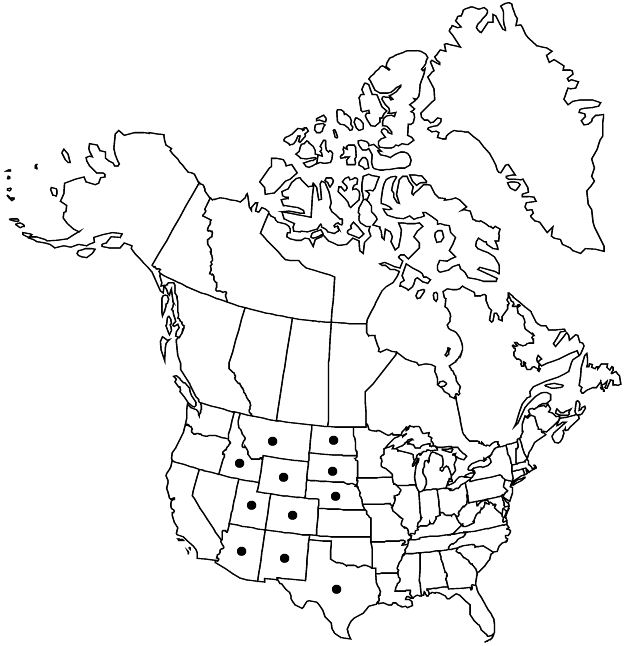Euphorbia brachycera
in W. H. Emory, Rep. U.S. Mex. Bound. 2(1): 192. 1859.
Herbs, perennial, with thick rootstock. Stems erect or ascending, branched, 10–60 cm, usually glabrous, sometimes puberulent. Leaves: petiole 0–0.5 mm; blade oblong-elliptic, lanceolate, or oblanceolate to broadly ovate, 5–25 × 2–7 mm, base truncate, rounded, acute, or attenuate, margins entire, apex acute or obtuse, sometimes mucronate, surfaces usually glabrous, sometimes puberulent; venation inconspicuous, only midvein prominent. Cyathial arrangement: terminal pleiochasial branches 3–5(–8), 1–4+ times 2-branched; pleiochasial bracts lanceolate or ovate to broadly ovate, wider than distal leaves; dichasial bracts distinct, broadly ovate or rhombic to triangular-ovate, base obtuse, margins entire or slightly crenate, apex obtuse, mucronate; axillary cymose branches 0–8. Cyathia: peduncle 0.4–1 mm. Involucre turbinate, campanulate or cupulate, 1.5–2.6 × 1.4–1.7 mm, usually glabrous, sometimes puberulent; glands 4, crescent-shaped to triangular-ovate, 0.5–0.8 × 0.7–1.7 mm, margins usually entire, occasionally slightly crenate to dentate; horns divergent, 0.2–0.4 mm, longer than teeth on gland margin. Staminate flowers 10–15. Pistillate flower: ovary, usually glabrous, sometimes puberulent; styles 0.5–0.9 mm, 2-fid. Capsules depressed-ovoid, 2.8–4 × 3.5–4.5 mm, 3-lobed; cocci rounded, smooth, usually glabrous, sometimes sparsely puberulent; columella 2.4–3.3 mm. Seeds light gray, cylindric ovoid-oblong, 2–2.8(–3) × 1.4–2.2 mm, irregularly shallowly pitted; caruncle sessile to shortly stipitate, conic, 0.4–0.5 × 0.8–1.1 mm. 2n = 28.
Phenology: Flowering and fruiting spring–summer.
Habitat: Montane areas, canyons, rock crevices, sandy or gravelly slopes, pine-oak woodlands, ponderosa pine and mixed coniferous forests.
Elevation: 1200–3200 m.
Distribution

Ariz., Colo., Idaho, Mont., Nebr., N.Mex., N.Dak., S.Dak., Tex., Utah, Wyo., Mexico (Chihuahua, Coahuila, Sonora).
Discussion
Euphorbia brachycera is morphologically extremely variable, and plants from the northern part of the species range have sometimes been distinguished as E. robusta. Euphorbia brachycera is most closely related to the other native, perennial species of subg. Esula in western North America, namely E. chamaesula, E. lurida, E. schizoloba, and E. yaquiana. The name E. montana Engelmann, which has sometimes been applied to E. brachycera, is illegitimate because it is a later homonym of E. montana Rafinesque.
Selected References
None.